


xxxxxThe Scottish
explorer David Livingstone went to southern Africa as a medical
missionary in 1840 and, based at Kuruman in today’s Cape Province,
spent eight years preaching, teaching and tending the sick. To
spread the gospel further, in 1849 he travelled north into
unexplored territory, crossing the Kalahari Desert and discovering
Lake Ngami. In 1853,
after his wife and children had returned to Scotland, he spent
four years penetrating further into the interior. With a small
party of Africans, he first made his way to Luanda, a port on the
west coast, and then, following the course of the Zambezi, he
reached the Indian Ocean in May 1856, becoming the first European
to see the Victoria Falls and cross the continent from west to
east. On his return to Britain he was welcomed as a national hero.
His Missionary Travels
and Researches in South Africa, plus his extensive
lecture tour, added to his fame, and did much to stimulate
interest in that part of the world. In 1858 he led a government
sponsored expedition into east and central Africa to promote
commerce and civilisation and put an end to the slave trade -
DAVID LIVINGSTONE 1813 -
(G3c, G4, W4, Va, Vb)
Acknowledgements
Livingstone:
after the English portrait painter Frederick Havill (c1815 -
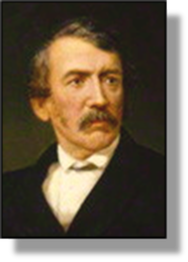 xxxxxThe Scottish missionary and explorer David
Livingston, was born in Blantyre, South Lanarkshire, a town about
12 miles south-
xxxxxThe Scottish missionary and explorer David
Livingston, was born in Blantyre, South Lanarkshire, a town about
12 miles south-
Including:
Paul Belloni du Chaillu

Va-
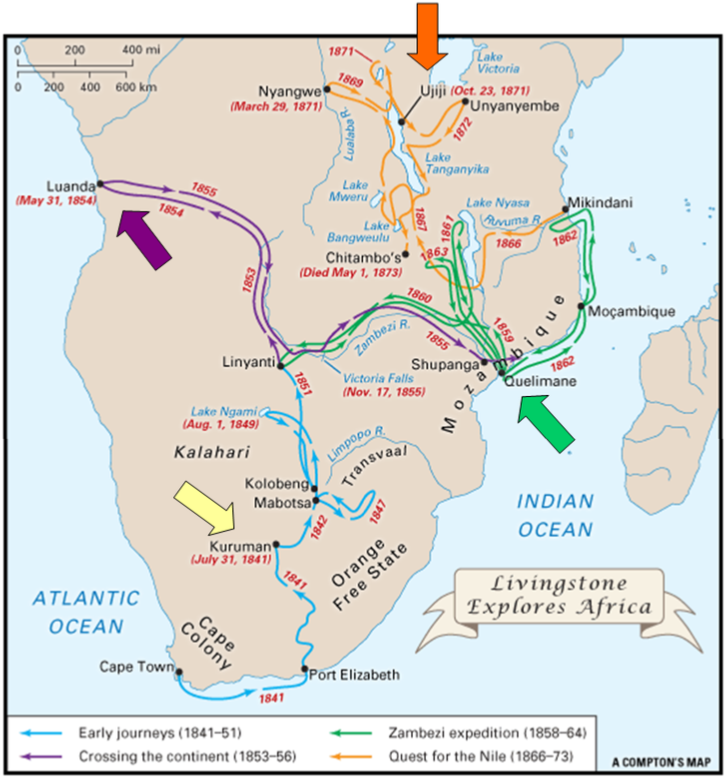
xxxxxHexarrived at Kuruman (arrowed on map above) in today’s Cape
Province in July 1841, and began preaching, teaching and tending
the sick at a missionary settlement in Bechuanaland (now
Botswana), founded in 1823 by Robert
Moffat (1795-
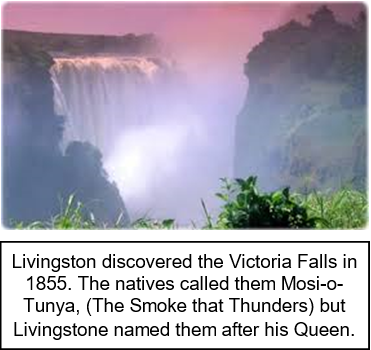 xxxxxIn 1852 his wife and four children returned to
Scotland, and Livingstone resumed his exploration, determined to
journey even deeper into central Africa or perish in the attempt.
Having been told of a mighty river -
xxxxxIn 1852 his wife and four children returned to
Scotland, and Livingstone resumed his exploration, determined to
journey even deeper into central Africa or perish in the attempt.
Having been told of a mighty river -
xxxxxOn his return to Britain in 1856, news of his extraordinary exploits had preceded him. He was welcomed as a national hero, and acknowledged as an outstanding explorer whose travels required a substantial revision of the contemporary maps of southern and central Africa. In the following year he produced his Missionary Travels and Researches in South Africa, a work which sold over 70,000 copies in a matter of weeks. And this, together with a lecture tour around Britain and the publication of Dr. Livingstone’s Cambridge Lectures of 1858, added to his fame, and did much to stimulate missionary and commercial work in that part of the world. Indeed, out of such exposure came the setting up of the Universities’ Mission to Central Africa in 1860. Furthermore, these lectures and writings encouraged other explorers to take up the African challenge, including Richard Burton and John Speke in 1858.
xxxxxIn 1858 the
British government, anxious to extend its knowledge of this area,
appointed him British consul for the east coast of Africa, based
at Quelimane (arrowed
on map above, in today’s Mozambique). From here he was required to
lead an expedition to explore east and central Africa “for the
promotion of Commerce and Civilisation and with a view to the
extinction of the slave trade”. (See green
journeys on map above.) This expedition
was on a grand scale compared with his earlier, lone ventures. The
party numbered seventeen, and the seven Europeans included his
wife Mary, his brother Charles, and John Kirk, a Scottish
physician. Supplies were plentiful and a paddle steamer was
provided to make the going much easier -
xxxxxDuring this sponsored expedition Livingstone’s reputation as an explorer suffered something of a setback. Nevertheless on his return to England in 1864, the general public applauded him for his dedication and courage. It was then that, with the assistance of his brother Charles, he wrote his second book, Narrative of an Expedition to the Zambesi and Its Tributaries, published the following year. Apart from a general account of the expedition, this roundly condemned the slave trade, describing the cruelty and misery inflicted on the local African tribes by the Arab and Portuguese slave traders in the area of Lake Nyasa. It was widely read in government circles and played a significant part in the eventual abolition of this trade.
xxxxxIt was
during his last expedition, begun in 1866 to discover the source
of the Nile (See orange journeys on map above), that
little was heard of his whereabouts and international concern grew
as to his safety. As we shall see, this eventually led to the
sending of a rescue party, led by the Welsh-
xxxxxIncidentally, quite apart from the
demanding and arduous nature of his exploration, Livingstone also
met with open hostility. This came not from the Africans -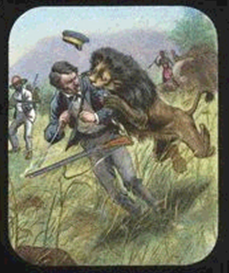 his
efforts on behalf of the natives. He often had to change his route
to avoid Portuguese settlements, and at one time, in 1852, the
Boers destroyed his home at Kolobeng and attacked Africans who had
joined his mission.
his
efforts on behalf of the natives. He often had to change his route
to avoid Portuguese settlements, and at one time, in 1852, the
Boers destroyed his home at Kolobeng and attacked Africans who had
joined his mission.
xxxxx…… In 1844 his career in Africa almost came to an abrupt end. He was travelling to Mabotsa, a native settlement some 200 miles north of Kuruman, to set up his own mission station, when he was suddenly attacked by a lion. He was badly mauled by the animal and was lucky to escape with his life. As it was, he was quite seriously injured and lost the full use of his left arm. ……
xxxxx…… Livingstone’s
adventures were not confined to the land. On his return to England
in 1864 he decided to travel via Bombay! He made the journey
across the Indian Ocean -
xxxxx…… In 1863 Livingstone’s eldest son, Robert, was due to join his father in Africa but, having difficulties over the journey, went to the United States instead. He was killed in December of the following year while fighting for the North in the American Civil War. ……
xxxxx…… Duringxhis Zambezi
expedition of 1858-
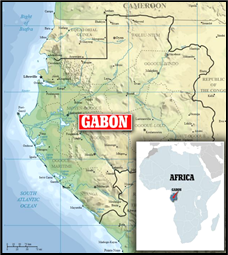 xxxxxIt was while Livingstone was
making his epic crossing of South Africa that the French-
xxxxxIt was while Livingstone was
making his epic crossing of South Africa that the French-


